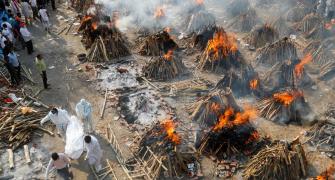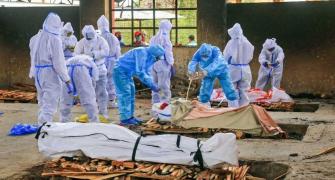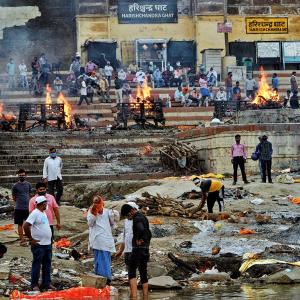An analysis of WHO data shows that most of the countries with an older cohort of population and higher in the development index had a lower excess mortality rate than India.

The ‘excess mortality’ figures released by the World Health Organisation, which put India at the top of the pecking order globally, reveal that neighbouring countries had a lower mortality rate. Experts slug it out amongst themselves on the methodology adopted by the global agency.
Countries like Pakistan, Bangladesh, Nepal, which have similar demographics and economic background as India have been estimated to have lower mortality rates than us, or countries with older people cohorts reporting lesser mortality.
A Business Standard analysis found that most of the countries with an older cohort of population and higher in the development index had a lower excess mortality rate than India.
For instance, Italy, where 23 per cent of the population was over the age of 65, the excess mortality rate according to WHO data was 0.27 per cent.
The US, which the WHO report highlights had 0.9 million excess mortality out of a population of 332 million, had a death rate of 0.28 per cent. The country had 15.4 per cent people over the age of 65.
In India, the 4.7 million excess deaths account for 0.34 per cent of population, even though the country's population cohort was much younger with only 6 per cent of the population over the age of 65.
India's excess mortality rate also does not match that of neighbours -- Bangladesh, Nepal and Pakistan -- which have a similar demographic profile, but lower excess mortality rate than India.
Pakistan's excess mortality rate as per WHO data was 0.1 per cent, Bangladesh was 0.08 per cent and Nepal was 0.11 per cent.
Consequently, analysis of data from Mumbai, which was giving timely updates on mortality figures, shows that the mortality rate among the older cohort was higher than the mortality rate among the younger population of infected people.
In the 30-39 age group, according to the latest available data, mortality in Mumbai was 0.3 per cent of the Covid cases. It rose to 1 per cent for the 40-49 age group and further to 2.3 per cent for people aged 50-59.
For those aged 60-69, mortality rate doubled again to 4.3 per cent and 6.8 per cent for 70-79 group.
WHO report pegs the deaths related to Covid-19 (both direct and indirect) at 47,40,894 during 2020 and 2021. Globally, this figure is 14.9 mn.
Excess mortality includes deaths directly due to coronavirus (Covid-19) disease or indirectly due to the pandemic’s impact on health systems and society. It is calculated as the difference between the number of deaths that have occurred and the number that would be expected in the absence of the pandemic based on data from earlier years.
Pronab Sen, former chief statistician of India, said that in the absence of a sample registration system (SRS), the only way to come up with a number on excess mortality is to do a mathematical modelling based projection. The real question to ask is, where SRS data is.
SRS was last released in 2019. Recently India released the Civil Registration System (CRS) report.
Some experts like Pronab Sen say that CRS and SRS data differ significantly. However, the government in its defence has pointed out that the completeness of death registry in India has touched 92 percent in 2019, and is now around 99 percent.
Sen pointed out that if India has the SRS data, it can use the data to do a sanity check on the WHO numbers of deaths projected during the Covid-19 pandemic. Also, India can suggest a methodology that can be used to arrive at the right estimation of excess deaths, he said.
India has officially recorded 481,486 Covid-19 deaths between January 1 2020 and December 31, 2021. Now, as far as total deaths go, the country has captured 8.1 mn deaths in 2020, according to the CRS reports in 2020, which says that the overall death registration (including deaths due to Covid and non-Covid) increased by 475,000 in 2020, compared with 2019.
Manindra Agarwal, the IIT Kanpur professor, whose mathematical modelling has been a point of reference to understand the pandemic in the last two years, said that on an average there is a 3 per cent rise in deaths every year over the previous one. Agarwal feels that the CRS 2020 data is quite an accurate dataset.
He feels that the WHO methodology to project excess mortality due to Covid-19 makes some key assumptions, for example, it considers that excess mortality is uniform across space and time. “This is a rather wrong assumption to make for a country as diverse and vast as India.”
“According to the CRS 2020, the total number of excess deaths in 2020 is 225,000. Typically, every year there is a 3 per cent increase in deaths over previous years, which is natural and also consistent. In 2020, the rise in deaths over 2019 was 6 percent. Therefore, there are an excess 3 per cent deaths which is due to Covid19 – directly or indirectly. That figure comes to 225,000 excess deaths,” he says.
He adds that India has reported around 150,000 Covid-19 deaths in 2020, therefore, the gap is around 70,000-75000 deaths at best.
“WHO pegs excess deaths for 2020 at close to 1 mn (8.3 lakh). This does not seem likely,” Agarwal says.
He feels that when one is making a mathematical model based on projections, one needs to have a sanity check. The CRS 2020 could have been that sanity check for the data for 2020.
“Covid deaths were primarily adult deaths, and the reporting of adult deaths in India is quite high. Infant deaths are often under-reported,” he adds.
In fact, India’s death reporting has improved over the years -- from 79 per cent in 2017 to 92 per cent in 2019, and the government claims that 99.95 per cent of all deaths were recorded in 2020.
A senior government official who has been part of India’s communications with the WHO pointed out that the global agency got back to them as late as April third week when they disclosed that they have used data from 17 states (revealing the names of the states) and the source websites and the Right to Information (RTI) based news articles.
“Initially, they came back with an excess mortality figure of 1.3 million, and then within fifteen days, they said that they had changed the model, and now the number was 3.3 million. This figure then changed to 6.2-6.3 million deaths, and the final figure was 4.7 million. The data metric was never shared with us,” the official alleged, requesting anonymity.
The BBC has reported quoting Ariel Karlinsky, a scientist who co-created the World Mortality Dataset and is a member of an advisory group set up by the WHO for its estimates of excess deaths caused by Covid globally during 2020 and 2021, that when in November 2020, researchers asked authorities in India to provide information, India said that those were not available.
Government sources defend that by saying that generating the CRS data is a statutory process, which has to be followed. But India is now open to sharing the CRS 2021 data with the WHO, as it has already shared the CRS 2020 data with the global agency.
Some experts point out the problem with using data from media reports based on RTI.
“Death reporting is also not a very uniform process, and there are delays in reporting varying across districts. This is a natural fluctuation. So, when we take data we take aggregate data. Data comes with errors, and therefore a positive error and a negative error balances out in aggregate data reporting,” Agarwal explains.
However, many reports have not used aggregate data from all districts, but a subset of districts. Therefore, there is a possibility of error as positive and negative errors cannot balance out, the professor adds.
The government official says that WHO’s non-acceptance of CRS data is strange, because the data is collected from the ground by 300,000 officers.
“WHO has put Iraq in the reported category instead of predicted. A country which is going through much political turmoil in the last few years has better reporting standards than India, they feel,” he says.











